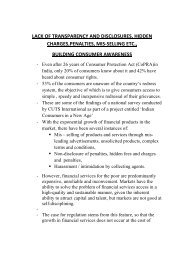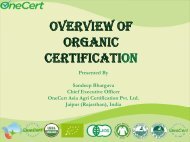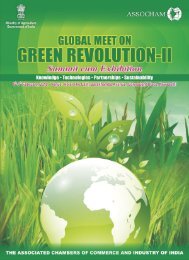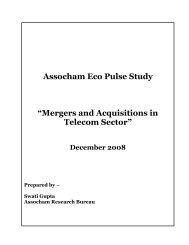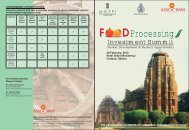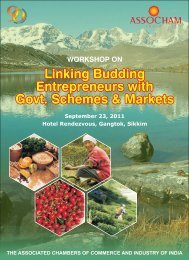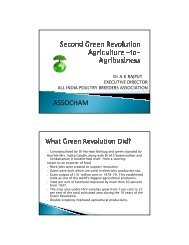Second Green Revolution Structure
Second Green Revolution Structure
Second Green Revolution Structure
You also want an ePaper? Increase the reach of your titles
YUMPU automatically turns print PDFs into web optimized ePapers that Google loves.
<strong>Second</strong> <strong>Green</strong> <strong>Revolution</strong><br />
Agriculture to agribusiness<br />
H. H. H. H. S. S. S. S. Gupta<br />
Gupta<br />
Gupta<br />
Gupta<br />
Indian Indian Indian Indian Indian Agricultural Agricultural Agricultural Agricultural Agricultural Research Research Research Research Research Institute Institute<br />
Institute<br />
Institute<br />
Institute<br />
New New New New Delhi Delhi-110012<br />
Delhi<br />
Delhi<br />
Delhi 110012<br />
110012<br />
110012<br />
<strong>Structure</strong><br />
1. Current Status of Agricultural Production<br />
2. Status of Food & Nutritional Security - Indian<br />
scenario<br />
3. The Challenges<br />
4. Strategies for meeting them through 2 nd GR<br />
5. Agriculture to Agribusiness : PPP need of<br />
the day<br />
6. New Initiatives of India in 12 th Plan
+ 6.7 bn ?<br />
+ 2.5 bn<br />
2.5 bn<br />
Global Population Explosion<br />
1985-2050<br />
1950-1985<br />
First 4 million years<br />
Present Concerns:<br />
Current: 7 billion (Oct. 2011)<br />
By 2050: 9.2 billion<br />
Poor: 1 billion (240 m in India)<br />
Underweight Children:<br />
Severely: 180 million<br />
Chronically: 800 million<br />
Vitamin A deficient: 200 million<br />
Pregnant Women:<br />
Anemia: 400 million<br />
Unprecedented Progress during<br />
the last 60 years<br />
• Increased agricultural production<br />
(from 50 MT to 252 MT)<br />
• Higher real income and reduced prices<br />
(from 1975 to 2007)<br />
• Reduced poverty<br />
(by 40%)<br />
• Life expectancy doubled<br />
(64 years)
Food Grains Production in India<br />
Productivity X3<br />
Production X5<br />
Area X0.25<br />
Production and Productivity of Wheat in India<br />
Prodn.x 9<br />
Yield x3<br />
Area x 2.5
Production and productivity of rice in India<br />
Source:: Evenson & Gollin (2003) CABI
Agricultural Production Scenario<br />
Commodity Production<br />
in 1950<br />
(Million tonnes)<br />
Food grains 50.00 252.0<br />
Vegetables 58.50 (91-92) 146.5<br />
Fruits 28.60 (91-92) 74.8<br />
Milk 17.00 104.8<br />
Production<br />
in 2011<br />
(Million tonnes)<br />
Egg (nos.) 1.80 53.5 billion<br />
Fish 0.75 7.3<br />
4-27 times increase in production of various commodities<br />
Reasons for Transformation<br />
GREEN REVOLUTION<br />
• Partnership with CGIAR Institutions<br />
• Adoption of HYVs along with associated technology<br />
• Joint efforts of<br />
– Polity<br />
– Bureaucrats<br />
– Agricultural scientists<br />
– Farmers<br />
• Contd. R&D in partnership with US Land Grant Institutionshelped<br />
in removing the minor deficiencies in Sonora 64 and<br />
Lerma Roho 64A
FUTURE CHALLENGES<br />
&<br />
STRATEGIES TO MEET THEM<br />
Food Requirement- Requirement<br />
Requirement- Indian Scenario<br />
Production 2010-11<br />
(Million tonnes)<br />
• Rice 103<br />
• Wheat 90<br />
• Coarse cer42<br />
• Pulses 17<br />
• Total 252<br />
• Oilseed-31 Million Tonnes<br />
Demand 2021<br />
(Million tonnes)<br />
120<br />
100<br />
40<br />
25<br />
• 285<br />
Will India import food grains in 2023
Food & Nutritional Security<br />
A Major Concern<br />
Can India Maintain Self-sufficiency<br />
Self sufficiency<br />
• Two school of thoughts<br />
– It’s very much possible<br />
– Not possible after 2023 unless<br />
• Increase investment<br />
• Improve irrigation<br />
• Improve factor productivity<br />
• Accelerate technology transfer<br />
Food Security – Paramount Importance<br />
Price fluctuation due to low production?
Fresh Water Resources – 4.6 %<br />
Land – 2.3 %<br />
Population – 17 %<br />
Rainfall – 1170 mm<br />
Resources and Liabilities<br />
Dr. S. Raman, New Delhi Winter<br />
School, 20/3/09<br />
XXXXXXXXXXXX<br />
The Challenges<br />
<strong>Second</strong> Generation Problems<br />
of <strong>Green</strong> <strong>Revolution</strong><br />
-Nutritional Nutritional Security?<br />
-Breaking Breaking yield barrier<br />
-Decline Decline in Factor Productivity<br />
- Soil Health and Water Table declining<br />
- Increased Incidence of Diseases and Pests<br />
- Climate change- change the biggest threat<br />
-
The Challenges<br />
Incidence of malnutrition among children<br />
(< 3 years)<br />
Percentage<br />
60<br />
50<br />
40<br />
30<br />
20<br />
10<br />
0<br />
Rural<br />
Urban<br />
All<br />
Severe Moderate Overall<br />
Undernutrition<br />
The Challenges<br />
Diversification of Crop sub Sector
The Challenges<br />
Raise Productivity<br />
(Small farms holdings)<br />
Increase Income<br />
(Low Cost technology)<br />
Manage Natural<br />
Resources
Efficiency<br />
100<br />
Strategy<br />
90<br />
80<br />
70<br />
60<br />
50<br />
40<br />
30<br />
20<br />
10<br />
40%-60%<br />
Irrigation Efficiency<br />
Breeding for response to low water<br />
50%-70%<br />
70%-85%<br />
Flood Furrow Sprinkler Center Pivot Drip<br />
Irrigation Methods<br />
80%-90%<br />
90%-95%<br />
Climate Change : Effect of Enhanced CO 2<br />
Change in insect-pest<br />
dynamics<br />
?
Climate Change<br />
Need for Anticipatory Research<br />
Wide Inter-Regional Inter Regional Variations in Yield<br />
Sl. No. State Food grain yield, 2009-10<br />
(t/ha)<br />
1. Punjab 4.1<br />
2 Tamil Nadu 2.5<br />
3 West Bengal 2.5<br />
4 Uttar Pradesh 2.2<br />
5 Bihar 1.5<br />
6 Orissa 1.4<br />
7 Madhya Pradesh 1.3<br />
Focus on high potential eastern region for<br />
immediate yield gains and inclusive growth
Recent Successes<br />
Bt Bt Cotton<br />
Cotton<br />
Recent Successes<br />
Area reached 8.4 m ha in 2011 nearly 85% of total area.<br />
Production doubled 2.3 mt in 2002 to 4.9 mt in 2010<br />
Pesticide consumption reduced by 40%<br />
12<br />
10<br />
Income of 5 m farmers increased substantially 8<br />
7.67 7.63<br />
6<br />
Cotton export fetched US $ >1.5 billion in 2010<br />
Soybean<br />
Area - 30, 000 ha (1970) to 10.3 Mha in 2011<br />
8.78 8.68<br />
9.14 9.44 9.37 9.6<br />
8.4<br />
7.6<br />
6.2<br />
1.25<br />
0.029 0.086 0.053<br />
Production - 0.14 MT (1970) to 12.4 MT in 2011<br />
Productivity - 430 kg/ha-----------to 1300 kg/ha in 2011- x3 times<br />
40% contribution to oilseed: 25% to edible oil of the country<br />
Million hectares<br />
4<br />
2<br />
0<br />
2002-<br />
03<br />
2003-<br />
04<br />
Adoption of Bt cotton in India<br />
2004-<br />
05<br />
2005-<br />
06<br />
3.8<br />
2006-<br />
07<br />
Year<br />
2007-<br />
08<br />
2008- 2009-<br />
09 10<br />
total (mha)<br />
Bt (mha)
Recent Successes- Successes contd<br />
• Potato production:<br />
• Area 0.54 mha in 1950 to 1.8 mha in 2011<br />
• Prodn. 1.56mt -------------- to 40 mt in 2011<br />
• Prody. 6t/ha-----------------to 20.5 t/ha<br />
• Prodn. 28 times: Productivity 3.5 times<br />
Basmati Rice :<br />
Volume of Export – 8 times in 20 yrs<br />
•<br />
1990 2010<br />
0.25 mt 2.0 mt<br />
Export earning increased significantly
Duration (days)<br />
170<br />
160<br />
150<br />
140<br />
130<br />
120<br />
110<br />
100<br />
<strong>Revolution</strong> in Basmati Rice<br />
Breeding for Earliness with higher yields<br />
Taraori<br />
Basmati<br />
Pusa Basmati<br />
1<br />
Pusa<br />
Sugandh 2<br />
Pusa RH 10<br />
(Hybrid)<br />
Single Single Single Single Cross Cross Cross Cross Cross Maize Maize Maize Maize Hybrids Hybrids Hybrids Hybrids in in in in India<br />
India<br />
India<br />
India<br />
7<br />
6<br />
5<br />
Yield (t/ha)<br />
• Maize production doubled during the last decade,<br />
• Productivity increased by 80%<br />
• Fastest growth rate (~8%) during the last 5 yrs. –<br />
highest among cereals<br />
• Maize production can further be doubled in next decade<br />
• Hybrid coverage to be increased (from current 35%)<br />
• QPM will help in reducing protein malnutrition (25% food)<br />
• QPM- feed for better conversion ratio in poultry (61%)<br />
• Baby corn export (1 million US $ in 2008 & 2009)<br />
4<br />
3<br />
2<br />
1<br />
0
Quality seed Production & Supply<br />
• Country’ requirement- 321 lakh q<br />
• Breeder seed production 100,000 q - ICAR’s Mega<br />
seed project - 6 lakh q seed in 2013-14<br />
• Total certified/quality seed expected 400 lakh q<br />
• Seed chain is not maintained<br />
• Revamp the seed production<br />
• 20% reserve seed for natural calamity affected<br />
areas<br />
Recent Successes<br />
Agriculture to Agribusiness
R&D R&D R&D R&D Investments Investments Investments Investments in in in in Asia Asia-Pacific<br />
Asia<br />
Asia<br />
Asia Pacific<br />
Pacific<br />
Pacific<br />
Region/<br />
Country<br />
Total spending<br />
(in million $ - 2005 international)<br />
Regional Share<br />
(%)<br />
1991 2002 2002<br />
China 1,174 2, 574 26.8<br />
South Asia<br />
Bangladesh 81 109 1.13<br />
Southeast Asia<br />
India 746 1,355 14.10<br />
Nepal NA 26 0.27<br />
Pakistan 223 171 1.78<br />
Sri Lanka 39 51 0.53<br />
Indonesia 220 177 1.84<br />
Laos NA 13 0.14<br />
Malaysia 227 424 4.41<br />
Philippines 80 141 1.47<br />
Vietnam 8 56 0.58<br />
ASTI-APAARI<br />
Public-Private Public Private Partnership<br />
• Storage<br />
– >60 million tonnes capacity<br />
– Fresh produce being added<br />
• Irrigation<br />
• Mechanization<br />
• Seed production<br />
• Processing & value chain<br />
• Non –farm enterprise –skill development
NEW INITIATIVES FOR ACCELERATING TECHNOLOGY<br />
DEVELOPMENT<br />
Conservation agriculture- 147M US $ with investment of 3 M $<br />
Promotion of legumes in Rice-wheat & rice fallows - 5-10<br />
MT additional pulses<br />
Expansion of area under Hybrid crops – viz. rice, maize &<br />
millets<br />
Development of borer resistant chickpea & pigeonpea<br />
Efficient use of rain, canal & waste water for enhancing WUE<br />
Development of climate resilient farming technology<br />
Solid waste management for compost production- soil fertility<br />
Capacity building through training programs for farmers<br />
Revamping education<br />
Strengthening management of IPR - Global seed business-<br />
3.5 b US $, India’s contribution ~1%<br />
CONCLUSION<br />
• 2/3 rd of India lives in villages and depends<br />
on agriculture<br />
• 9% growth in GDP can be supported on if<br />
Ag. GDP grows @ 4%<br />
• Investment in agriculture - PPP is the need<br />
of the hour<br />
• Evergreen revolution is possible provided<br />
we support agriculture
Consumption of Chemical Fertilizers
Way Forward<br />
India-Africa India Africa Partnership<br />
• India-Africa Forum Summit in 2008<br />
– Agriculture for meeting growing demand for nutritious food<br />
India-Africa Institute for Agriculture & Rural Development<br />
Farm Science Centers<br />
Seed production-cum- demonstration centers<br />
Rural technology parks<br />
Capacity building in food processing in Sub-Saharan Africa<br />
- 500 scholarships in Agril Sciences<br />
- 700 Science Fellowships<br />
- Short term training courses<br />
Global conference on Conservation Plant Genetic Resources<br />
from 4th to 6 th September 2012<br />
– Agro-climatic conditions of Africa is similar to<br />
India- Technology can be refined and then taken to<br />
Africa<br />
Way Forward - Partnership<br />
Past Successes<br />
– Rice Biotechnology- Rockefeller Foundation<br />
New Programs<br />
– Network Projects in crop improvement<br />
• Maize – MAB for biotic & abiotic stresses-<br />
• Conservation agriculture for raising system productivity<br />
and conserving resources<br />
• Rice - Golden rice for β carotene<br />
• Tuber crops for disease-free planting materials<br />
• Grain legumes for resistance to stored grain pests
Acknowledgements<br />
FAO for Invitation<br />
EPSO for sponsoring consultation<br />
Colleagues at Indian Agricultural Research<br />
Institute, New Delhi<br />
&<br />
Indian Council of Agricultural Research<br />
Mexican Wheat in India<br />
Dwarf wheat travelled from Japan to US to Mexico and to India<br />
• Salmon (USDA) to Vogel (WSU) to Borlaug (CIMMYT) to IARI<br />
• Rabi 1961-62 -Observational Nursery from USDA<br />
• Summer 1962 -Multiplication at Wellington in Southern India<br />
• Rabi 1962-63 -Demonstration at IARI farm in New Delhi<br />
Dr. Borlaug invited & visited in March 1963<br />
• Rabi 1963-64 -Multilocation Trial 4 places<br />
• Rabi 1964-65 -Large Multilocation trails-155 places<br />
• 1965- Two Mexican Lines Sonora 64 & Lerma Roho 64 A Released<br />
for Commercial cultivation by CVRC (CSCSNRV)<br />
• 18,000 tonnes seeds imported despite scarce foreign exchange<br />
• Yield increased from 8.3 q/ha in1965-66 to 13 q/ha in 1970-71<br />
• Similar was the story in rice with introduction of IR8-dwarf rice<br />
INDIA BECAME SELF-SUFFICIENT IN FOOD GRAINS IN EARLY 1970s
Biotechnology at Crossroads?<br />
• 134 m ha under transgenic crops since 1966 – 46% in<br />
developing countries (China, India, Brazil, Argentina,<br />
Paraguay and South Africa)<br />
• Crops: Soybean, Maize, Cotton, Canola<br />
• Traits: Insects, Herbicides, Viruses<br />
• More than 50 crops and forestry trees are being<br />
targeted currently<br />
• Tissue culture for propagation of plating material for<br />
horticultural crops<br />
• Which is the path we want to take?<br />
• Science-led or otherwise based on emotions
Bridging the Yield Gap<br />
1. Transfer of Technology<br />
a. Dissemination of HYVs - Seed production & SRR - very low<br />
b. Balanced use of fertilizers – 156 kg/ha India against 396 kg/ha in China<br />
c. Judicious use of water – Increasing WUE<br />
d. Increasing cropping intensity – 14 mha rice fallows in Eastern India<br />
e. Diversification with HVC & LS -Increasing Increasing prod. per unit area & profitability<br />
f. Supply of right input- input On time and doorstep of farmers<br />
2. Raising Productivity of RFAs- RFAs Watershed approach<br />
3. Farming System Approach- Approach Raising system productivity rather than of component crops<br />
3. IPM & IPNM- IPNM Biological control & site-specific site specific nutrient management<br />
4. Sustainability to Irrigated Areas- Areas Mung bean in wheat-rice wheat rice system<br />
5. Linking farmers to market- market For increasing profitability
Productivity of Selected crops (Kg/ha)<br />
Yield Increase x 3.35, 0.83 , x 4.43 x1.85<br />
668-2240, 788-655, 663-2938, 842-896<br />
Options for Reducing Emissions<br />
• Avoiding Deforestation<br />
• Minimizing soil erosion risks<br />
• Eliminating biomass burning and<br />
incidence of wild fires<br />
• Improving input use efficiency (e.g.,<br />
fertilisers, energy, water, pesticides)<br />
• Healthy rice and bovine animal<br />
production (aerobic rice, DSR, Proper<br />
feed management etc.)
Source: FAO<br />
Maize Yields, 1961-2009 1961 2009<br />
Still not enough<br />
• India invests relatively a small amount in<br />
agricultural R&D as measured by its intensity<br />
ratio.<br />
Agricultural R&D spending<br />
as a share of AgGDP<br />
3.5<br />
3.0<br />
2.5<br />
2.0<br />
1.5<br />
1.0<br />
0.5<br />
0.0<br />
Preliminary data not for citation<br />
India China SSA Brazil USA Australia



